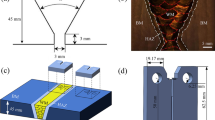Abstract
AISI 304B4 stainless steel (SS) containing 1.3 wt% boron is reported to be weldable under moderate restraint forces provided welding parameters are chosen carefully. However, during fabrication of components, extensive cracking issues are being reported. Hence, a study involving assessment of base metal, unmixed zone and partially melted zone (PMZ) of 304B4 steel and its welds made using E309 and boron containing consumables on hot cracking is carried out. In this article, results obtained on cracking susceptibility of PMZ formed in this steel are presented and discussed. In order to evaluate hot ductility behavior of PMZ formed in unmixed zone in a multipass weld, PMZ was first simulated using “Gleeble™” thermo-mechanical simulator. Subsequently, hot ductility tests were conducted on this simulated PMZ. Results of the study showed that liquation cracking susceptibility of PMZ of this steel subjected to repeated thermal cycle is higher than that of 304B4 base material. Microstructural analysis of tested specimens showed that formation of Fe-rich ((Fe,Cr)2B + Cr2B) borides in PMZ lowers ductility recovery temperature by 50 °C which results in an increase in cracking factor by 84% of that of base metal. Reasons for high cracking susceptibility of PMZ formed on fused 304B4 have been deduced.













Similar content being viewed by others
References
Park TD, Baek KK, Kim DS (1997) PWHT effect on mechanical properties of borated stainless steel GTA weldments for nuclear shield. Met Mater 3:46–50
(2000) Standard specification for borated stainless steel plate, sheet and strip for nuclear applications. ASTM A887, Edition 1989
Kumar P, Pai A (2014) An overview of welding aspects and challenges during manufacture of intermediate heat exchangers for 500mwe prototype fast breeder reactor. Proc Eng 86:173–183
Divya M, Albert SK (2018) Dilution effects on weld metal microstructure and liquation cracking susceptibility of 304B4 SS joined using E309 electrode. J Manuf Process 34:540–554
Kou S (2003) Welding metallurgy, 2nd edn. John Wiley & Sons, Inc., Hoboken, pp 252–253 ISBN 0-471-43491-4
Srinivasan G, Divya M, Das CR, Albert SK, Bhaduri AK, Lauf S, Stubenrauch S, Klenk A (2015) Weldability studies on borated stainless steel using Varestraint and Gleeble tests. Weld World 59:119–126
Böllinghaus T, Herold H (2005) Hot cracking phenomenon in welds. Springer Berlin Heidelberg, New York, pp 347–375 ISBN 3-540-22332-0
Musech H (1985) Welding of material grade TP347 modified. Nucl Eng Des 85(2):155–161
Shinodo T, Miyake H, Matsuzaka T, Matsumoto T, Kanai H (1992) Hot cracking susceptibility of boron modified AISI 304· austenitic stainless steel welds. Mater Sci Technol 8:913–992
Acknowledgements
The authors acknowledge the support and dedication received from Professor G.D. Janaki Ram and Mr. K. Rangan for his support during hot ductility experiments. The authors also thank Dr. Chitta Ranjan Das, SO/G, MJS, for his valuable support for arranging WDS analysis. The authors are thankful to Dr.Raju, PMD for extending his support for DSC experiments.
Author information
Authors and Affiliations
Corresponding author
Additional information
Publisher’s note
Springer Nature remains neutral with regard to jurisdictional claims in published maps and institutional affiliations.
Recommended for publication by Commission IX - Behaviour of Metals Subjected to Welding
Rights and permissions
About this article
Cite this article
Divya, M., Albert, S.K. & Rajnikanth, V. Liquation cracking susceptibility of partially melted zone in 304B4 SS multipass weldments. Weld World 63, 1101–1113 (2019). https://doi.org/10.1007/s40194-019-00738-9
Received:
Accepted:
Published:
Issue Date:
DOI: https://doi.org/10.1007/s40194-019-00738-9



